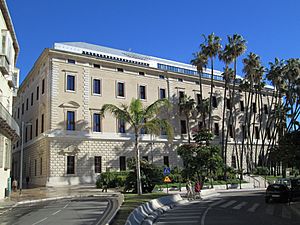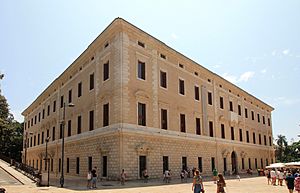Palacio de la Aduana facts for kids
The Palacio de la Aduana, which means "Customs Palace," is a very important building in Málaga, Andalusia, Spain. It was first built to be a customs house for the Port of Málaga. This is where officials would check goods coming into the city.
Contents
Building the Palace
The idea for the Palacio de la Aduana came from Manuel Martín Rodríguez in 1787. Charles III of Spain, who was the king at the time, approved the plan. Building work started in 1791.
Pedro Ortega Monroy, who managed customs, was in charge of the project. Architects Miguel del Castillo and Ildefonso Valcárcel designed the main front of the building and its layout.
The construction faced some challenges. In 1810, while it was still being built, French forces took over Málaga during the Peninsular War. The building was damaged during this time.
After the war, the damage was fixed, and construction continued. Another architect, Pedro Nolasco Ventura, made some changes to the plans. The palace was finally finished in 1829.
Palace Design
The Palacio de la Aduana is built in the Neoclassical style. This style was popular in the late 1700s and early 1800s. It was inspired by the grand buildings of ancient Rome and Renaissance Italy.
The palace has four main sections that surround a central open space called a patio. The first two floors of the patio have porticos, which are covered walkways with columns.
On the third floor, the patio is set back, creating an open gallery. This gallery has a decorative balustrade (a fancy railing) that acts like a low wall. Between parts of this wall, you can see Roman busts, which are sculptures of people's heads and shoulders. The outside walls of the building have a special rough stone finish called bossage. Tall palm trees stand proudly next to the main entrance.
What the Palace Was Used For
Over the years, the Palacio de la Aduana has had many different jobs:
- Customs House: It started as a place to check goods coming into the port.
- Tobacco Factory: Later in the 1800s, it became the Royal Tobacco Factory.
- Government Offices: It also served as the main office for the city government.
- Spanish Government Subdelegation: From the time of Francisco Franco, it housed a branch of the Spanish government.
- Police Station: Parts of the building were also used by the National Police.
Around 2004, the building was still used by the government and police. It also started to store art from the Fine Arts section of the Museo de Málaga. This happened because the museum's previous home, the Buenavista Palace, was taken over by the Museo Picasso Málaga.
The Great Fire
The original roof of the palace was destroyed by a fire when it was a tobacco factory. A much more serious fire happened on April 25–26, 1922. At this time, the building was being used by the government.
The fire started in the wooden staircases leading to the top floor. About 70 government workers lived on that floor. Sadly, 28 people died in the fire, and many years of important government records were lost.
The Palace Today
As of February 2012, the Palacio de la Aduana was being restored to become the permanent home for the Museo de Málaga. The Ministry of Culture hired a construction company called Sacyr to do the work.
Architects Fernando Pardo, Bernardo García Tapia, and Ángel Pérez Mora designed the restoration. The project was planned to cost 23.6 million euros. The museum was expected to open in 2013.
See also
 In Spanish: Palacio de la Aduana (Málaga) para niños
In Spanish: Palacio de la Aduana (Málaga) para niños



